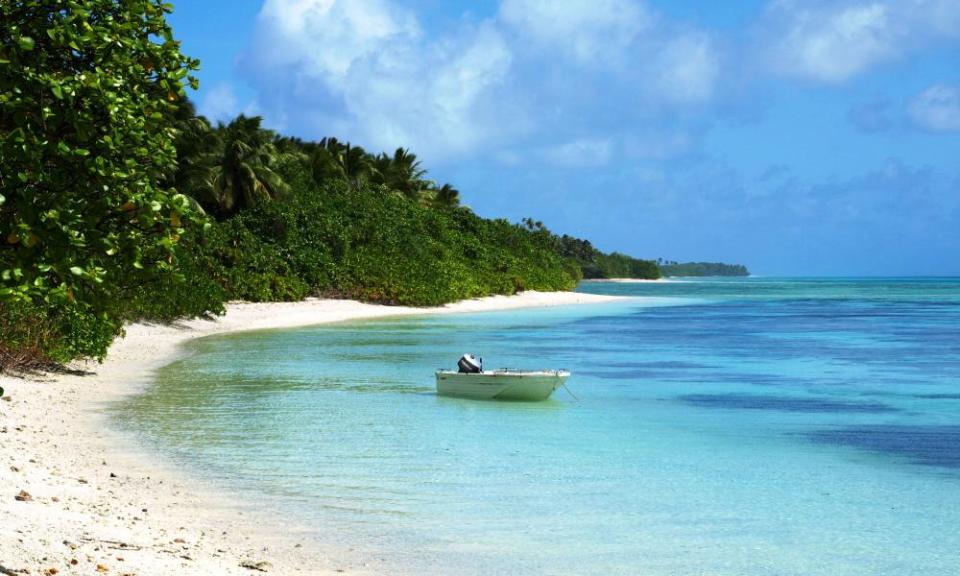A favourite reef, a beloved atoll: Marshall Islands parents name children after vanishing landmarks
Every summer when Tony Paul was a child in Kwajalein, an atoll in the Pacific nation of the Marshall Islands, his parents sent him and his siblings to spend time with their uncle on a remote chain of islands their ancestors once called home.
During the day, they darted across shrub-covered dunes and waded through turquoise waters. During the evening, they spearfished in the lagoon or hunted coconut crabs. And every night, before they went to bed, their uncle pulled out a battered guitar and sang old Marshallese pop songs. “They were the best times of being a kid,” Paul says. “It was a chance for us to learn a lot of Marshallese ways.”
Related: Rising sea levels threaten Marshall Islands’ status as a nation, World Bank report warns
Paul later moved to Majuro, the Marshall Islands’ capital. It became difficult and time-consuming to visit the islands of his childhood. But he still carried those memories. And when he met Ellen Milne, who would later become his wife, they discovered a surprising connection: she too could trace her family’s lineage to islands near there.
So when it came time to choose their second daughter’s name (Milne-Paul’s mother selected the name of the first), the islands sprang to mind. They named their daughter Elenak, after the second-largest island in the chain. By doing so, they hoped they were “giving her something that connects her to her Marshallese roots”, Milne-Paul says. Later, when their youngest son was born, they named him Tarlan, after an ancient coral head in Kwajalein’s lagoon.
It was once rare for Marshallese children to be given such names: most received the names of relatives. In recent years, however, and among better-off Marshallese, there has been a small surge in children named after the places from which their families come, highlighting the emotionally-laden ways Pacific Islanders are grappling with the future of a region battling economic challenges and climate turmoil.
The surge in place-based names – which is hard to quantify due to a lack of any hard data – is largely due to the growing likelihood that Marshallese children will one day leave their home. Education in the Marshall Islands is poor, few students who graduate can find jobs, and most jobs that do exist pay little: the median annual income is $9,600. Because the country is a former American colony, its citizens can live in the US without a visa. Faced with these economic conditions, many have chosen to do so: between 2011 and 2021, the country’s population dropped from 53,158 to 43,594.
This is further complicated by climate change. The low-lying atoll nation is already feeling the impact by way of intense droughts and more frequent flooding from king tides and outbreaks of mosquito-borne illnesses. Saltwater is increasingly soaking into the land, spoiling crops and freshwater supplies. In 2018, the US Geographical Survey released a study of a representative Marshallese island indicating that if moderate greenhouse gas emissions continue, sea level rise will make Marshallese freshwater supplies undrinkable by 2035 and cause annual floods of the majority of Marshallese land by 2055. As a result, Marshallese migration is expected to accelerate in coming years.

‘Rooted to this reef forever’
Milne-Paul says their decision to name Elenak and Tarlan after the islands they love so much was mainly driven by the Marshall Islands’ economic challenges and their hope that their children will one day pursue opportunities overseas. When they do, she says, their names will give them an important connection to the country of their birth.
She says she is still coming to terms with the growing impact of climate change on her islands. As she does so, however, she has grown to realise the deeper significance of the names. “It would mean so much more that it’s an island that used to exist, and no longer exists,” she says.
Among the notable Marshallese whose children share their name with local islands or plots of land are the country’s highest civil servant, Kino Kabua, and its most famous poet, Kathy Jetñil-Kijiner, who named her daughter Peinam, after a parcel of land belonging to her mother’s family.
She says most Marshallese name their children after ancestors to keep those people’s legacy alive. She hopes that by naming her daughter after Peinam, she can similarly ensure that the place’s legacy endures, even if the land itself sinks. The name represents their choice “to be rooted to this reef forever”, she says.
Jetñil-Kijiner now serves as a climate advocate for the Marshallese government. As Peinam grows into adulthood, Jetñil-Kijiner says she hopes her name helps tie her to the islands. “I definitely prioritise making sure she feels a connection to these islands that are threatened, that are under siege, and that are going to be changing because of climate change.”
Milne-Paul agrees. “We’re going to live and die here,” she says. But for Elenak and Tarlan, “should they leave, if they decide to become a permanent resident abroad, they’ll still be connected to this country”.

 Yahoo News
Yahoo News 
